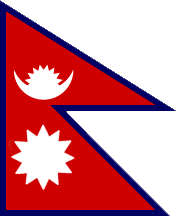
Flag adopted 12 December 1962, coat of arms adopted 16 December 1962.

Last modified: 2006-06-09 by ian macdonald
Keywords: nepal | star | crescent | triangle | face |
Links: FOTW homepage |
search |
disclaimer and copyright |
write us |
mirrors

![]() 5:4, image by André Coutanche
5:4, image by André Coutanche
Flag adopted 12 December 1962, coat of arms adopted 16 December 1962.
According to the very precise construction details contained in the Nepalese
Constitution, the proportions of the flag are 4:3 plus width of the blue border
(which makes the upper pendant longer than the lower because of its sharper
angle).
Christopher Southworth, 13 May 2003
The moon in the upper part represents the royal house. The sun in the lower part symbolizes a branch of the Rana family, members of which acted as prime ministers until 1961.
The charges are now said to represent the hope that Nepal itself will last as long as the sun and the moon. The style of these heavenly bodies was streamlined on December 16, 1962. The coat of arms still portrays these charges with facial features. Crimson is deemed the national color.
Motto on their coat of arms: "The mother and the Mother Earth are more important than the heavenly kingdom."
Sources:
Alter (1986) Banderas y escudos del mundo (Flags and coats of arms of the world). Madrid: EASA (1986).
Flags. Philadelphia: Running Press (1994)
The Observer's Book of Flags. London: Frederick Warne & Co. Ltd. (1966)
Juan Vaquer, Jr., 25 February 1999
The faces were removed in 1962, I believe.
John Ayer, 30 September 2000
Some other attributions have been reported to FOTW concerning the origin and meaning of the flag:
Prior to the adoption of the present national flag on Dec16 1962, flags with faces were used in Nepal:
Image based on Flaggenbuch:
![[Old Nepali Flag]](../images/n/np_1939.gif) image by Jaume Ollé, 27 June 2001
image by Jaume Ollé, 27 June 2001
Image based on Flags of All Nations:
![[Old Nepali Flag]](../images/n/np_1958.gif) image by Jaume Ollé, 27 June 2001
image by Jaume Ollé, 27 June 2001
Nozomi Kariyasu, 27 June 2001
Information on a more ancient representation of the Nepali flag can be found in M. Lupant's book:
The first reproduction of the Nepali flag found by M. Lupant is shown in
a book published by Perceval Laundon in 1928 (Nepal, vol. 1, pp.
233-236, Constable, London). The flag was crimson with a green border.
It was made of two superposed isoceles triangles. The two points could
have symbolized the royalty and the Rana family. The moon symbolized the
King and the sun symbolized the Rana family. Moon and Sun expressed the
hope that the Nation shall live as long as them.
The faces are both shown with ears and a symbol in the middle of the
forehead (probably one of the coloured spots used by Hinduists, whose
name I forget), and the face in the upper triangle has a small neck
putting it above the moon.
Ivan Sache, 27 June 2001
Probably the answer is easier, if the question is asked the other way round:
Why are all national flags (except for the Nepali one) rectangular?
The pretty uniform shape of the national flag can be probably explained by the
fact that the national flag has its origin in a limited area (Europe and
Mediterranean), as ship flags. Certainly there had been different shapes in the
early times, but rectangular clothes of an approximate proportion of between
1.5:1 and 2:1 seemed the most practical ones, so the countries "standardized"
this shape. Afterwards the ship flags had been adapted for terrestrial use.
National flags of countries outside Europe only developed after European
national flags had standardized their shape, so they were imitating the
rectangular shape as well as some of the symbolic elements (vertical/horizontal
stripes, for instance). Older national symbols were transformed to the
"European" flag shape, for instance in Ethiopia, where the originally separated
red, yellow and green pennants were transformed into a horizontal triband of
rectangular shape. Nepal retained the original shape of its flag (basically two
pennants one above the other). The first origin of this flag is probably
elusive. However, other flags in the Indian area also showed non-rectangular,
often pennant-like shape, see
http://fotw.vexillum.com/flags/in-princ.html#alpha. The Nepali flag is
probably the only one surviving, something like a "living fossil". Usually
living fossils survive in rather secluded areas, such as Nepal (not having
coastal access, and being mountainous) or Switzerland (the same), still sticking
to the square shape of its flags.
Marcus E.V. Schmöger, 17 July 2004
![[Nepali Air force marking]](../images/n/np^afmk.gif) image by Eugene Ipavec, 30 May 2006
image by Eugene Ipavec, 30 May 2006
Red six-pointed star (like a Magen David, filled)
bordered white and containing a black trident. national flag on the fin.
Željko Heimer, 3 July 2002
The Royal Nepalese Army, Air Wing, was formed in the mid 1960's and became
the Royal Nepal Air Force in July 1979 when it adopted the marking.
Dov Gutterman, 20 June 2004
![[Nepali Peace Flag]](../images/n/np-shiv.gif) image by Roman Kogovsek, 9 July 2005
image by Roman Kogovsek, 9 July 2005
I have seen this flag across Nepal and in Darjeeling. I was told that it is a
Peace flag. It has 16 red rays on a yellow field with a yellow circle and eight
pointed star in the middle. The script is in English and in Nepali: Supreme
Father Shiv.
Roman Kogovsek, 9 July 2005